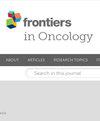通过放射组学鉴别嗜铬细胞瘤和肾上腺类脂腺瘤:增强型 CT 扫描图像是否必要?
IF 3.5
3区 医学
Q2 ONCOLOGY
引用次数: 0
摘要
目的 建立基于常规CT扫描图像和增强CT图像的各种放射组学模型,探讨其在嗜铬细胞瘤(PHEO)和贫脂性肾上腺腺瘤(LPA)分类中的价值,并筛选出最合理、最有效的模型方法 回顾性分析青岛大学附属医院332例经手术病理证实的PHEO或LPA患者(352个病灶)的临床和影像学资料。使用 ITK-SNAP 软件在常规和增强 CT 图像上划分感兴趣区(ROI)。根据从常规和增强 CT 图像中提取的放射组学特征构建不同的放射组学特征,并计算放射组学评分(Rad score)。利用人口统计学特征和CT结果建立了临床模型,并利用多元逻辑回归分析建立了放射组学提名图。结果基于传统 CT 图像的放射组学特征的 AUC 为 0.97(训练队列,95% CI:0.95∼1.00)和 0.97(验证队列,95% CI:0.92∼1.00)。基于常规扫描 CT 图像和增强 CT 图像的提名图模型在训练队列和验证队列中的 AUC 分别为 0.97(95% CI:0.95∼1.00)和 0.97(95% CI:0.94∼1.00)以及 0.98(95% CI:0.97∼1.00)和 0.97(95% CI:0.94∼1.00)。基于增强 CT 图像的模型的预测效率略高于基于传统 CT 图像的模型,但差异无统计学意义(P>0.05)。基于传统 CT 图像建立的模型具有很高的识别和预测效率,还能使患者避免在传统图像检查中因需要进一步增强扫描而受到辐射和造影剂的伤害。本文章由计算机程序翻译,如有差异,请以英文原文为准。
Differentiation of pheochromocytoma and adrenal lipoid adenoma by radiomics: are enhanced CT scanning images necessary?
PurposeTo establish various radiomics models based on conventional CT scan images and enhanced CT images, explore their value in the classification of pheochromocytoma (PHEO) and lipid-poor adrenal adenoma (LPA) and screen the most parsimonious and efficient modelMethodsThe clinical and imaging data of 332 patients (352 lesions) with PHEO or LPA confirmed by surgical pathology in the Affiliated Hospital of Qingdao University were retrospectively analyzed. The region of interest (ROI) on conventional and enhanced CT images was delineated using ITK-SNAP software. Different radiomics signatures were constructed from the radiomics features extracted from conventional and enhanced CT images, and a radiomics score (Rad score) was calculated. A clinical model was established using demographic features and CT findings, while radiomics nomograms were established using multiple logistic regression analysis.The predictive efficiency of different models was evaluated using the area under curve (AUC) and receiver operating characteristic (ROC) curve. The Delong test was used to evaluate whether there were statistical differences in predictive efficiency between different models.ResultsThe radiomics signature based on conventional CT images showed AUCs of 0.97 (training cohort, 95% CI: 0.95∼1.00) and 0.97 (validation cohort, 95% CI: 0.92∼1.00). The AUCs of the nomogram model based on conventional scan CT images and enhanced CT images in the training cohort and the validation cohort were 0.97 (95% CI: 0.95∼1.00) and 0.97 (95% CI: 0.94~1.00) and 0.98 (95% CI: 0.97∼1.00) and 0.97 (95% CI: 0.94∼1.00), respectively. The prediction efficiency of models based on enhanced CT images was slightly higher than that of models based on conventional CT images, but these differences were statistically insignificant(P>0.05).ConclusionsCT-based radiomics signatures and radiomics nomograms can be used to predict and identify PHEO and LPA. The model established based on conventional CT images has great identification and prediction efficiency, and it can also enable patients to avoid harm from radiation and contrast agents caused by the need for further enhancement scanning in traditional image examinations.
求助全文
通过发布文献求助,成功后即可免费获取论文全文。
去求助
来源期刊

Frontiers in Oncology
Biochemistry, Genetics and Molecular Biology-Cancer Research
CiteScore
6.20
自引率
10.60%
发文量
6641
审稿时长
14 weeks
期刊介绍:
Cancer Imaging and Diagnosis is dedicated to the publication of results from clinical and research studies applied to cancer diagnosis and treatment. The section aims to publish studies from the entire field of cancer imaging: results from routine use of clinical imaging in both radiology and nuclear medicine, results from clinical trials, experimental molecular imaging in humans and small animals, research on new contrast agents in CT, MRI, ultrasound, publication of new technical applications and processing algorithms to improve the standardization of quantitative imaging and image guided interventions for the diagnosis and treatment of cancer.
 求助内容:
求助内容: 应助结果提醒方式:
应助结果提醒方式:


